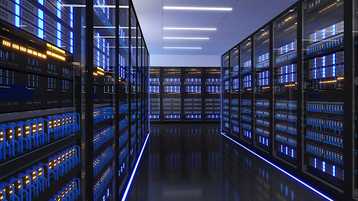Data centers are the backbone of the digital economy, but their high energy consumption and space needs pose significant challenges. In 2022, data centers globally consumed approximately 460 TWh of electricity, accounting for about two percent of the world’s electricity usage (Electricity 2024: Analysis and forecast to 2026).
With AI, cryptocurrency, and cloud services driving high demand, operators face increasing pressure to reduce energy consumption, optimize operational space, and comply with stringent sustainability regulations.
At a new multi-building data center near Milan – situated in one of Europe’s fastest-growing cloud markets – these pressures were compounded by the need to provide low-latency services to hyperscalers and enterprise clients. The facility required innovative solutions.
Overcoming space and energy challenges
Like many data centers, the Milan facility would have struggled with traditional backup power systems. Conventional lead-calcium batteries take up substantial physical space, limiting room for additional servers that could generate revenue.
Energy efficiency was another concern, as high electricity costs and strict EU sustainability regulations required significant reductions in consumption without compromising reliability. Finally, the facility needed to ensure operational continuity during power fluctuations, an ongoing challenge given the region's high energy demand.
Advanced battery technology from EnerSys provided a solution that addressed these intersecting challenges. By combining increased energy density, improved efficiency, and flexible applications, new battery systems offered the Milan facility the tools it needed to optimize space, cut costs, and enhance resilience.
Delivering measurable outcomes
Adopting advanced thin plate pure lead (TPPL) technology enabled the Milan data center to achieve several critical outcomes. The batteries’ higher energy density reduced their physical footprint by 25 percent, freeing up room for additional servers and boosting revenue potential.
Energy efficiency is also projected to improve, with the facility anticipated to achieve a 30 percent reduction in electricity consumption compared to traditional lead-calcium batteries, due to the TPPL batteries’ lower float current and advanced electrochemical performance.
Reliability was enhanced through faster recharge capabilities, ensuring the system was ready to handle power fluctuations with minimal downtime. These operational improvements were complemented by sustainability benefits, including a longer battery lifespan – up to 25 percent longer than conventional systems – and 99 percent recyclability, reducing both waste and environmental impact.
Future-proofing data center operations
In addition to addressing immediate needs, the advanced battery technology positioned the Milan facility to adopt forward-looking energy strategies. By using batteries equipped with TPPL technology, the facility gained the ability to support grid balancing by storing energy during off-peak periods and discharging it during high-demand times, stabilizing grid fluctuations and cutting costs. These systems are also compatible with fast frequency response (FFR), which delivers short bursts of energy to balance grid frequency with minimal wear.
Thermal management was another key benefit, with cooling systems accounting for as much as 40 percent of total energy consumption in data centers (DOE Announces $40 Million for More Efficient Cooling for Data Centers, May 9, 2023). However, the DataSafe XE batteries installed in Milan can operate effectively at higher ambient temperatures, reducing the need for intensive cooling.
Studies indicate that even a 1°C (33.8°F) increase in server inlet temperatures can lower cooling costs by four percent, giving operators the opportunity to achieve significant savings while lowering their carbon footprint. These capabilities ensure that the Milan data center has the means to be competitive and adaptable in a rapidly evolving energy landscape.
Lessons from Milan: Collaboration drives innovation
The Milan facility’s success demonstrates the importance of combining advanced technology with a collaborative approach to energy management. By rethinking traditional systems and adopting innovative backup power solutions, data centers can address today’s challenges while preparing for future demands.
Advanced battery technology from EnerSys has not only helped the Milan data center overcome critical operational hurdles, but also positioned it for long-term sustainability and resilience in an ever-evolving energy landscape. For operators in Europe and beyond, the lessons from Milan underscore the potential of innovative energy solutions to deliver efficiency, adaptability, and lasting value.


